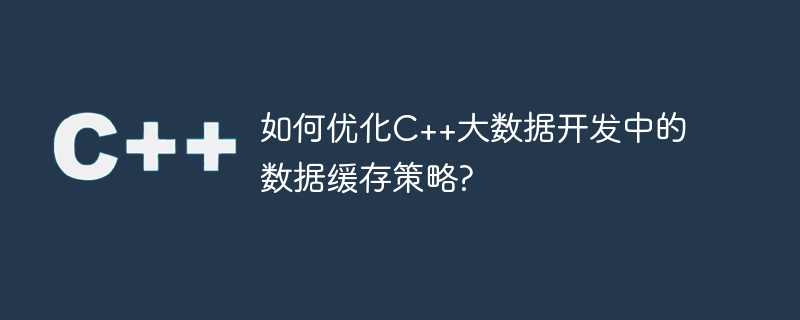
如何优化C++大数据开发中的数据缓存策略?
在大数据开发中,数据缓存是一种常用的优化手段。通过将频繁访问的数据加载到内存中,可以大幅提升程序的性能。本文将介绍如何在C++中优化数据缓存策略,并给出相关的代码示例。
一、使用LRU缓存算法
LRU(Least Recently Used)是一种常用的缓存算法。它的原理是将最近使用过的数据放在缓存的前面,最不经常使用的数据放在缓存的后面。当缓存满时,如果需要新加入的数据不在缓存中,则删除最不经常使用的数据,将新数据放在缓存的前面。我们可以利用STL中的list和unordered_map来实现LRU缓存算法。具体实现如下:
立即学习“C++免费学习笔记(深入)”;
#include <list>
#include <unordered_map>
template <typename Key, typename Value>
class LRUCache {
public:
LRUCache(int capacity) : m_capacity(capacity) {}
Value get(const Key& key) {
auto it = m_map.find(key);
if (it == m_map.end()) {
return Value();
}
m_list.splice(m_list.begin(), m_list, it->second);
return it->second->second;
}
void put(const Key& key, const Value& value) {
auto it = m_map.find(key);
if (it != m_map.end()) {
it->second->second = value;
m_list.splice(m_list.begin(), m_list, it->second);
return;
}
if (m_map.size() == m_capacity) {
auto last = m_list.back();
m_map.erase(last.first);
m_list.pop_back();
}
m_list.emplace_front(key, value);
m_map[key] = m_list.begin();
}
private:
int m_capacity;
std::list<std::pair<Key, Value>> m_list;
std::unordered_map<Key, typename std::list<std::pair<Key, Value>>::iterator> m_map;
};二、预读数据
在大数据处理中,通常会有许多连续的数据访问。为了减少IO开销,我们可以在程序执行过程中预读一定量的数据到内存中。下面是一个简单的预读数据的示例代码:
#include <fstream>
#include <vector>
void preReadData(const std::string& filename, size_t cacheSize, size_t blockSize) {
std::ifstream file(filename, std::ios::binary);
if (!file) {
return;
}
std::vector<char> cache(cacheSize, 0);
while (!file.eof()) {
file.read(&cache[0], blockSize);
// 处理读取的数据
}
file.close();
}以上代码会将文件按照指定的块大小读进一个缓冲区,然后进行处理。通过调整cacheSize和blockSize的大小,可以根据实际情况来进行优化。

本书是全面讲述PHP与MySQL的经典之作,书中不但全面介绍了两种技术的核心特性,还讲解了如何高效地结合这两种技术构建健壮的数据驱动的应用程序。本书涵盖了两种技术新版本中出现的最新特性,书中大量实际的示例和深入的分析均来自于作者在这方面多年的专业经验,可用于解决开发者在实际中所面临的各种挑战。 本书内容全面深入,适合各层次PHP和MySQL开发人员阅读,既是优秀的学习教程,也可用作参考手册。
 253
253

三、使用多线程和异步IO
在大数据处理中,IO操作往往是程序性能的瓶颈之一。为了提高IO效率,可以使用多线程和异步IO的方式。下面是一个使用多线程读取数据的示例代码:
#include <iostream>
#include <fstream>
#include <vector>
#include <thread>
void readData(const std::string& filename, int start, int end, std::vector<char>& data) {
std::ifstream file(filename, std::ios::binary);
if (!file) {
return;
}
file.seekg(start);
int size = end - start;
data.resize(size);
file.read(&data[0], size);
file.close();
}
void processLargeData(const std::string& filename, int numThreads) {
std::ifstream file(filename, std::ios::binary);
if (!file) {
return;
}
file.seekg(0, std::ios::end);
int fileSize = file.tellg();
file.close();
int blockSize = fileSize / numThreads;
std::vector<char> cache(fileSize, 0);
std::vector<std::thread> threads;
for (int i = 0; i < numThreads; ++i) {
int start = i * blockSize;
int end = (i + 1) * blockSize;
threads.emplace_back(readData, std::ref(filename), start, end, std::ref(cache));
}
for (auto& t : threads) {
t.join();
}
// 处理读取的数据
}以上代码会使用多个线程同时读取文件的不同部分,然后将数据合并到一个缓存区进行处理。通过调整numThreads的数量,可以根据实际情况来进行优化。
总结
在C++大数据开发中,优化数据缓存策略能够显著提升程序的性能。本文介绍了使用LRU缓存算法、预读数据以及使用多线程和异步IO的方法。读者可以根据自己的需求和场景来选择合适的优化方法,并结合具体的代码示例进行实践。
参考资料:
以上就是如何优化C++大数据开发中的数据缓存策略?的详细内容,更多请关注php中文网其它相关文章!

c++怎么学习?c++怎么入门?c++在哪学?c++怎么学才快?不用担心,这里为大家提供了c++速学教程(入门到精通),有需要的小伙伴保存下载就能学习啦!

Copyright 2014-2025 https://www.php.cn/ All Rights Reserved | php.cn | 湘ICP备2023035733号